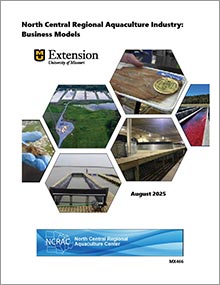Editor’s note
The following abstract describes a publication that is only available as a downloadable PDF. See the Excel workbooks Pond-Raised Recreational Stocking and Food Fish Aquaculture Budgets (XLSX) and Recirculating Aquaculture System (RAS) Budgets (XLSX) for related information.
Summary

This report is designed for aquaculture entrepreneurs seeking business model examples in the North Central region of the U.S. The North Central region (NCR) aquaculture industry is diverse. Varied topography, climate and groundwater availability have guided existing operation locations. Mild winters in the more southern states provided certain aquaculture pioneers with a more favorable production season than other states. Cold-water species find better growth conditions in the northern NCR states.
Nationwide, aquaculture is a growing industry with clusters of highly developed and specialized businesses. Examples of successful regional clusters include trout farms along the rivers of Idaho and catfish operations in the southeastern Mississippi River Delta states. Other areas of the U.S. are home to operations serving exclusively local demand or specific niches and market segments. California has several examples of niche fresh fish operations. Fish market segments could include raising fish for pond stocking; rearing fish for conservation departments and municipalities to fill lakes and rivers; and producing tropical, premium or specialty fish for local food and consumer markets.
Business models for 10 different species–market combinations grown in ponds and another six species–market combinations grown in recirculating aquaculture systems (RAS) were developed in this study. Departing from a common farm size and RAS structure, the 16 business models detailed in this report were designed to take advantage of emerging aquaculture opportunities, build upon NCR’s current industry strengths, avoid apparent weaknesses and steer around threats posed by competitive aquaculture businesses. These models are identified in Exhibit S1 and shown with various business characteristics. They were developed as entry-level firms and chosen to be large enough to fully employ a family’s labor and yet small enough to focus on niche markets rather than compete with large firms.
Whenever available, all technical parameters and specifications were grounded in past technical publications. Price values were gathered from websites and fish suppliers in the North Central region. Fish prices showed large variation depending on the quantity purchased and the location of the fish farm, so we used prices closer to the median and gave preference to sources that represented prices for sales in larger quantities (and thus closer to wholesale prices). Two accompanying tools were developed alongside this report to allow producers to customize technical parameters and price values, enabling them to generate budgets that reflect their specific plans or operational realities.
When combining climate and market factors, it is clear there is no one-size-fits-all operation suitable for North Central region aquaculture. The region has a range of climate conditions and/or water resource availability, which also impacts the viability of each of the species analyzed in this study. Many times, the conditions present for a startup business are not comparable to those in areas outside the North Central region where large-scale aquaculture markets exist, such as parts of Idaho and the southeast. For these reasons, opportunities for startup aquaculture operations in the North Central region are mostly focused on specialty or value-added products at a scale that supports a single family.
Contents
- Summary
- Freshwater pond culture models
- Background
- Capital investments and operating inputs
- Channel catfish model (food market)
- Hybrid striped bass model (food market)
- Yellow perch model (food market)
- Bluegill model (stocking market)
- Channel catfish model (stocking market)
- Golden shiner (baitfish market)
- Grass carp model (stocking market)
- Hybrid striped bass model (stocking market)
- Largemouth bass model (stocking market)
- Yellow perch model (stocking market)
- Recirculating aquaculture system (RAS) models
- Background
- Capital investments
- Salmon model (food market)
- Trout model (food market)
- Trout model (stocking market)
- Walleye model (stocking market)
- Yellow perch model (food market)
- Yellow perch model (stocking market)
- Summary of business models
Pages
- 51